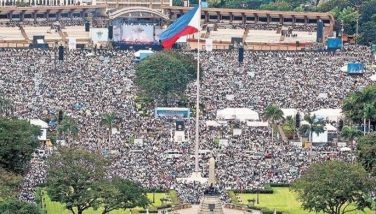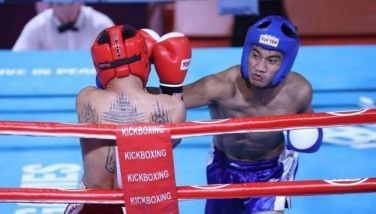Philharmonic concerts: A magnificent Maazel, an electrifying Lang
October 23, 2002 | 12:00am
Wielding the baton sans score – with each note embedded in his memory – Lorin Maazel took music lovers to glorious heights – at the Citibank’s invitational gala last week in the CCP auditorium.
If one were to single out the most distinguishing quality of the NY Philharmonic – America’s oldest orchestra of over a hundred members – it would be its tremendous vitality. To be sure, superbly controlled dynamics, precision, discipline, solidly adhesive projection – all these were present likewise in total measure as the ensemble interpreted the selections.
These were Beethoven’s Leonore Overture No. 3 which recapitulates episodes of the opera Fidelio; La Mer, a symphonic poem drawn from Debussy’s actual experience of the sea, and Sibelius’s Symphony No. 2 in D Major.
In Beethoven’s overture, and to a certain degree in Sibelius’s symphony, each composer often focused on the brasses to underscore and heighten the drama inherent in the music. How compelling the brasses were in performance! The verve and vigor of Beethoven’s mighty orchestration was, in rendition, majestic.
Debussy calls La Mer Three Symphonic Sketches: From Dawn Till Noon on the Sea, The Play of the Waves, and Dialogue of the Wind and the Sea. Years ago, the composition conjured to a musicologist "the great empty spaces of ocean as they change under light and wind." Less graphically or in academic terms, another described it as "Debussy’s response to thoughts about the sea and its moods". In any case, under Maestro Maazel’s baton, orchestral delineation was so eloquent, the onrushing waves were almost palpable, leaving this reviewer to conclude that never had impressionism turned to realism more vividly.
Judging by the initial passages of Sibelius’s symphony, the audience would have assumed it dull, vapid, undistinguished. Yet, as it progressed, one found one’s self listening with keener attention to the strings tautly shimmering in strikingly refined sonorities to convey the exquisite lyricism of the andante sostenuto, lente e suave, and largamente in the succeeding movements.
More astounding still, the seemingly unrelated, disparate movements came together in a surprising, unexpected yet singularly logical integration that produced an overwhelming, indeed, shattering impact.
Deafening applause and a standing ovation from the full house marked the concert’s end. The unceasing clamor for encores was graciously accommodated by the Maestro with an excerpt from Bizet, and as the tumultuous din continued, with one of Brahms’ Hungarian Dances in G Minor if anyone in the audience did not feel like dancing to the rousing, sweep and drive of the music, he must have needed a hearing aid – desperately.
In her opening remarks, Catherine M. Weir, Citibank’s Country Corporate Officer, revealed that the bank, which marks its 100th year of existence in the Philippines, has been sponsoring the NY Philharmonic’s international tours for the 22nd time. Special guests of the gala invitational concert were Alfonso Bolipata’s young musical talents from Casa San Miguel in Zambales and wards from Don Bosco in Manila.
Strongly Russian in spirit, the second NY Philharmonic concert at the CCP auditorium featured Mussorgsky’s Night on Bald Mountain, Rachmaninoff’s Piano Concerto No. 2 with the 20-year-old Chinese Lang Lang as piano soloist, and Tchaikovsky’s Symphony 5 in E Minor.
Divesting Night on Bald Mountain (as arranged by Rimsky-Korsakov) of its meaning – as a Midsummer Night fertility folk festival involving water nymphs and other supernatural beings of the nether world, the work’s propulsive robustness and raw Slavic energy surfaced again and again – this owing largely to the excellent, impressively impeccable work of the percussion, brass and woodwind sections. The orchestral translation of a pagan festival which generated considerable excitement, finished on a quiet rot.
Lang Lang made his entrance with head held high, doubtless to denote supreme self-confidence, his smile quickly captivating his audience. The opening chords which slowly increased to a ponderous fortissimo were later turned into clear, limpid cascading notes by strikingly nimble and agile fingers, thus quickly suggesting a brilliant technique. Further on, in the cadenza, Lang Lang displayed uncommon sensitivity for both the lyrical and the dramatic. Here was an awesomely talented 20-year-old – indeed a pupil worthy of his mentor Gary Graffman, himself a pianist who had demonstrated his extraordinary gifts (of which this reviewer wrote) some years back in Manila.
Twice Maestro Maazel cast a glance at the youthful soloist to ensure rapport. Yet this was total throughout, the Maestro’s beat and Lang Lang’s own struck in flawless, balanced unison.
Precious few pianists, seasoned or otherwise, "survive" the final "onslaught" of the tutti passages which include the daunting thunder of the percussions. Lang Lang triumphantly asserted himself at the finale. Tumultous cheers and several curtain calls for conductor and soloist ensued.
Infinite variety of mood, treatment and content characterized Tchaikovsky’s Symphony. The dirge-like opening of both the first and second movements offered a stark contrast to the breezy dance theme. Introduced by a wind soloist, it was repeated by the cellos and by the violins in utterly exquisite interplay.
The masterful orchestration of Tchaikovsky’s symphony offered an interesting contrast to Sibelius’s equally masterful symphony which was played earlier. Although the various movements of the latter came together only in the end, the constant repetition of the Fate motif in Tchaikovsky’s symphony clearly served as a unifying element from the start yet with both masterpieces closing in a towering climax.
Wild, unending applause and a standing ovation greeted the Maestro once more. The orchestra then rendered an excerpt from Glinka’s opera Russlan and Ludmilla. The cheers grew even more clangorous. "This is most unexpected, but the NY Philharmonic is always ready to expect the unexpected," the Maestro said. "Lest you think we know nothing but Russian music, we’ll play a Hungarian dance by Brahms." It was after a repeat of the Hungarian dance, also in G Minor, previously heard at the gala, that the orchestra members stood up, leaving the audience wanting more.
If one were to single out the most distinguishing quality of the NY Philharmonic – America’s oldest orchestra of over a hundred members – it would be its tremendous vitality. To be sure, superbly controlled dynamics, precision, discipline, solidly adhesive projection – all these were present likewise in total measure as the ensemble interpreted the selections.
These were Beethoven’s Leonore Overture No. 3 which recapitulates episodes of the opera Fidelio; La Mer, a symphonic poem drawn from Debussy’s actual experience of the sea, and Sibelius’s Symphony No. 2 in D Major.
In Beethoven’s overture, and to a certain degree in Sibelius’s symphony, each composer often focused on the brasses to underscore and heighten the drama inherent in the music. How compelling the brasses were in performance! The verve and vigor of Beethoven’s mighty orchestration was, in rendition, majestic.
Debussy calls La Mer Three Symphonic Sketches: From Dawn Till Noon on the Sea, The Play of the Waves, and Dialogue of the Wind and the Sea. Years ago, the composition conjured to a musicologist "the great empty spaces of ocean as they change under light and wind." Less graphically or in academic terms, another described it as "Debussy’s response to thoughts about the sea and its moods". In any case, under Maestro Maazel’s baton, orchestral delineation was so eloquent, the onrushing waves were almost palpable, leaving this reviewer to conclude that never had impressionism turned to realism more vividly.
Judging by the initial passages of Sibelius’s symphony, the audience would have assumed it dull, vapid, undistinguished. Yet, as it progressed, one found one’s self listening with keener attention to the strings tautly shimmering in strikingly refined sonorities to convey the exquisite lyricism of the andante sostenuto, lente e suave, and largamente in the succeeding movements.
More astounding still, the seemingly unrelated, disparate movements came together in a surprising, unexpected yet singularly logical integration that produced an overwhelming, indeed, shattering impact.
Deafening applause and a standing ovation from the full house marked the concert’s end. The unceasing clamor for encores was graciously accommodated by the Maestro with an excerpt from Bizet, and as the tumultuous din continued, with one of Brahms’ Hungarian Dances in G Minor if anyone in the audience did not feel like dancing to the rousing, sweep and drive of the music, he must have needed a hearing aid – desperately.
Divesting Night on Bald Mountain (as arranged by Rimsky-Korsakov) of its meaning – as a Midsummer Night fertility folk festival involving water nymphs and other supernatural beings of the nether world, the work’s propulsive robustness and raw Slavic energy surfaced again and again – this owing largely to the excellent, impressively impeccable work of the percussion, brass and woodwind sections. The orchestral translation of a pagan festival which generated considerable excitement, finished on a quiet rot.
Lang Lang made his entrance with head held high, doubtless to denote supreme self-confidence, his smile quickly captivating his audience. The opening chords which slowly increased to a ponderous fortissimo were later turned into clear, limpid cascading notes by strikingly nimble and agile fingers, thus quickly suggesting a brilliant technique. Further on, in the cadenza, Lang Lang displayed uncommon sensitivity for both the lyrical and the dramatic. Here was an awesomely talented 20-year-old – indeed a pupil worthy of his mentor Gary Graffman, himself a pianist who had demonstrated his extraordinary gifts (of which this reviewer wrote) some years back in Manila.
Twice Maestro Maazel cast a glance at the youthful soloist to ensure rapport. Yet this was total throughout, the Maestro’s beat and Lang Lang’s own struck in flawless, balanced unison.
Precious few pianists, seasoned or otherwise, "survive" the final "onslaught" of the tutti passages which include the daunting thunder of the percussions. Lang Lang triumphantly asserted himself at the finale. Tumultous cheers and several curtain calls for conductor and soloist ensued.
Infinite variety of mood, treatment and content characterized Tchaikovsky’s Symphony. The dirge-like opening of both the first and second movements offered a stark contrast to the breezy dance theme. Introduced by a wind soloist, it was repeated by the cellos and by the violins in utterly exquisite interplay.
The masterful orchestration of Tchaikovsky’s symphony offered an interesting contrast to Sibelius’s equally masterful symphony which was played earlier. Although the various movements of the latter came together only in the end, the constant repetition of the Fate motif in Tchaikovsky’s symphony clearly served as a unifying element from the start yet with both masterpieces closing in a towering climax.
Wild, unending applause and a standing ovation greeted the Maestro once more. The orchestra then rendered an excerpt from Glinka’s opera Russlan and Ludmilla. The cheers grew even more clangorous. "This is most unexpected, but the NY Philharmonic is always ready to expect the unexpected," the Maestro said. "Lest you think we know nothing but Russian music, we’ll play a Hungarian dance by Brahms." It was after a repeat of the Hungarian dance, also in G Minor, previously heard at the gala, that the orchestra members stood up, leaving the audience wanting more.
BrandSpace Articles
<
>
- Latest
- Trending
Trending
Latest




























